Blockchain Applications: Bitcoin and Ethereum
VerifiedAdded on 2023/06/14
|6
|1730
|463
AI Summary
This report outlines a brief description on the entire concept of blockchain and its two major applications, viz. Bitcoin and Ethereum. The field and purpose of these applications will be provided here. Moreover, the complete working model of the application will be given here. The advantages and disadvantages of Bitcoin and Ethereum will also be depicted here.
Contribute Materials
Your contribution can guide someone’s learning journey. Share your
documents today.
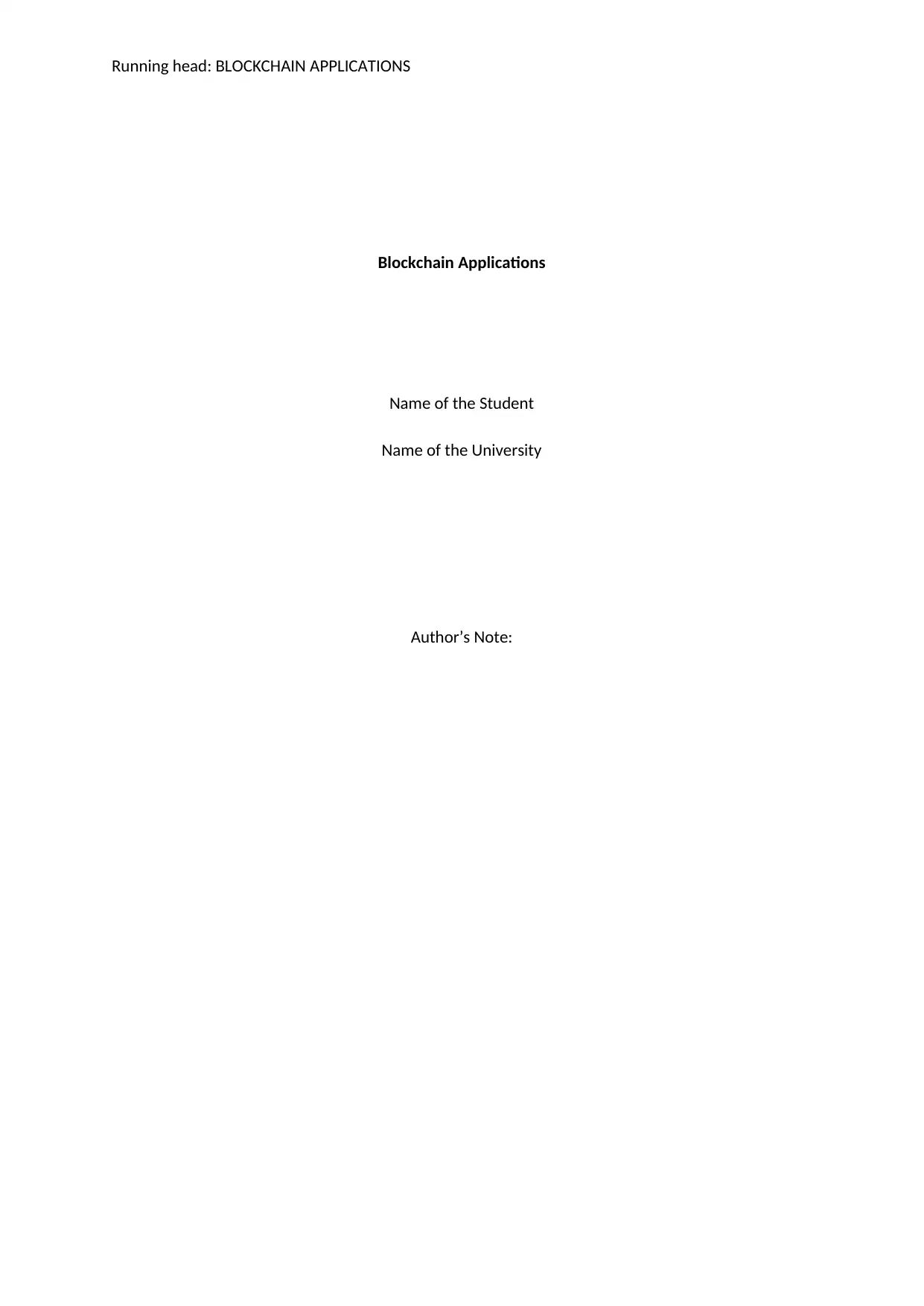
Running head: BLOCKCHAIN APPLICATIONS
Blockchain Applications
Name of the Student
Name of the University
Author’s Note:
Blockchain Applications
Name of the Student
Name of the University
Author’s Note:
Secure Best Marks with AI Grader
Need help grading? Try our AI Grader for instant feedback on your assignments.
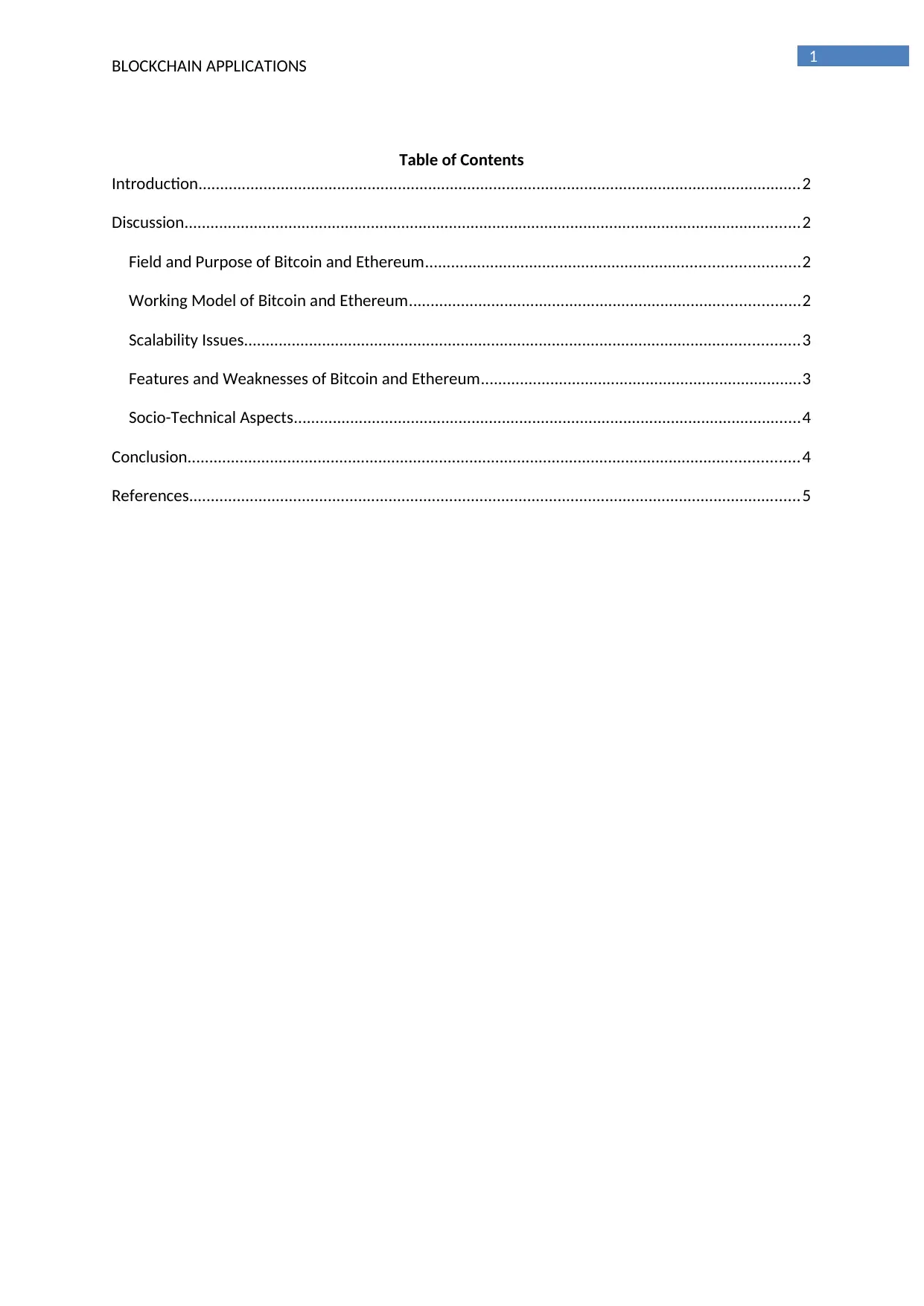
1
BLOCKCHAIN APPLICATIONS
Table of Contents
Introduction...........................................................................................................................................2
Discussion..............................................................................................................................................2
Field and Purpose of Bitcoin and Ethereum......................................................................................2
Working Model of Bitcoin and Ethereum..........................................................................................2
Scalability Issues................................................................................................................................3
Features and Weaknesses of Bitcoin and Ethereum..........................................................................3
Socio-Technical Aspects.....................................................................................................................4
Conclusion.............................................................................................................................................4
References.............................................................................................................................................5
BLOCKCHAIN APPLICATIONS
Table of Contents
Introduction...........................................................................................................................................2
Discussion..............................................................................................................................................2
Field and Purpose of Bitcoin and Ethereum......................................................................................2
Working Model of Bitcoin and Ethereum..........................................................................................2
Scalability Issues................................................................................................................................3
Features and Weaknesses of Bitcoin and Ethereum..........................................................................3
Socio-Technical Aspects.....................................................................................................................4
Conclusion.............................................................................................................................................4
References.............................................................................................................................................5
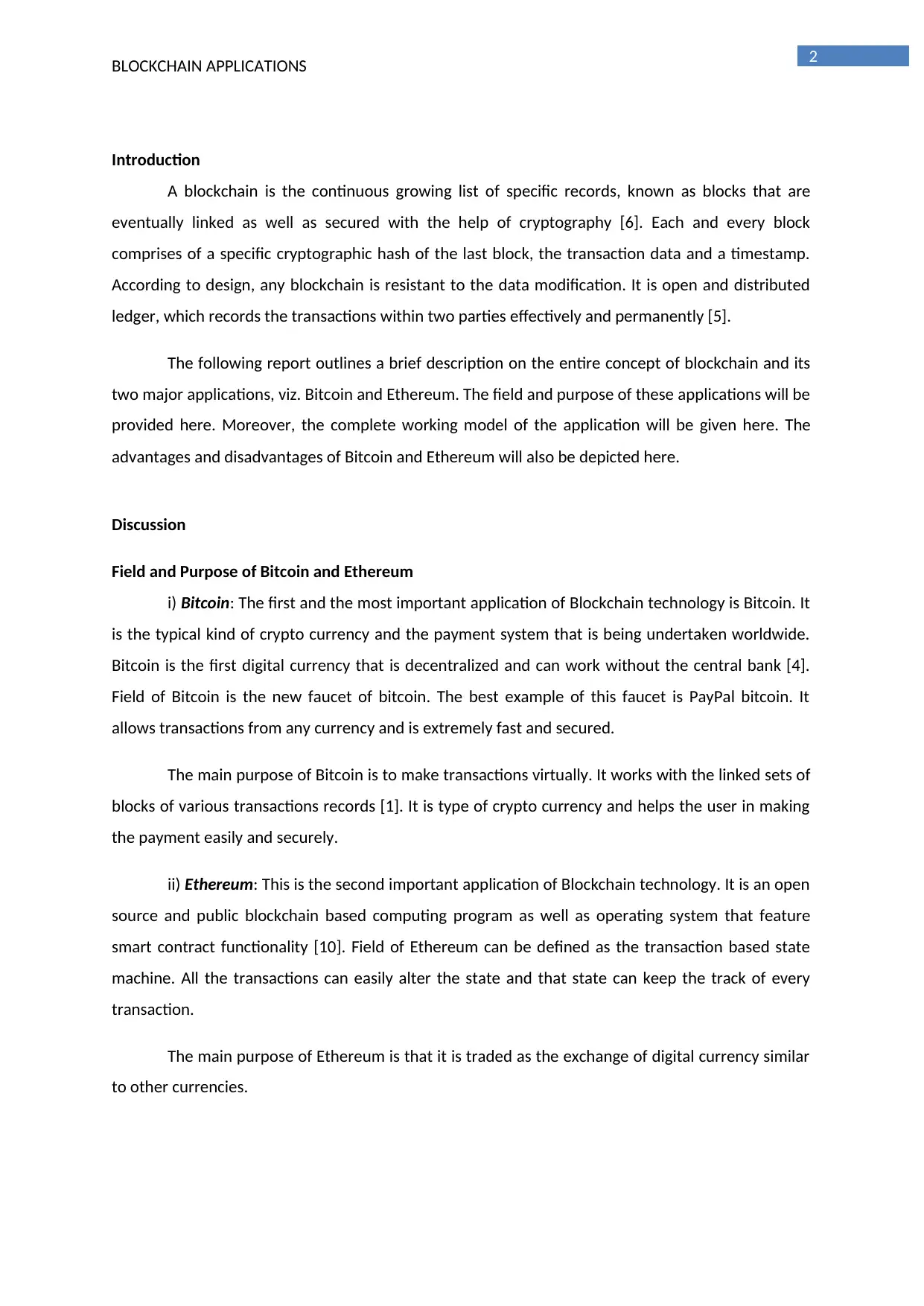
2
BLOCKCHAIN APPLICATIONS
Introduction
A blockchain is the continuous growing list of specific records, known as blocks that are
eventually linked as well as secured with the help of cryptography [6]. Each and every block
comprises of a specific cryptographic hash of the last block, the transaction data and a timestamp.
According to design, any blockchain is resistant to the data modification. It is open and distributed
ledger, which records the transactions within two parties effectively and permanently [5].
The following report outlines a brief description on the entire concept of blockchain and its
two major applications, viz. Bitcoin and Ethereum. The field and purpose of these applications will be
provided here. Moreover, the complete working model of the application will be given here. The
advantages and disadvantages of Bitcoin and Ethereum will also be depicted here.
Discussion
Field and Purpose of Bitcoin and Ethereum
i) Bitcoin: The first and the most important application of Blockchain technology is Bitcoin. It
is the typical kind of crypto currency and the payment system that is being undertaken worldwide.
Bitcoin is the first digital currency that is decentralized and can work without the central bank [4].
Field of Bitcoin is the new faucet of bitcoin. The best example of this faucet is PayPal bitcoin. It
allows transactions from any currency and is extremely fast and secured.
The main purpose of Bitcoin is to make transactions virtually. It works with the linked sets of
blocks of various transactions records [1]. It is type of crypto currency and helps the user in making
the payment easily and securely.
ii) Ethereum: This is the second important application of Blockchain technology. It is an open
source and public blockchain based computing program as well as operating system that feature
smart contract functionality [10]. Field of Ethereum can be defined as the transaction based state
machine. All the transactions can easily alter the state and that state can keep the track of every
transaction.
The main purpose of Ethereum is that it is traded as the exchange of digital currency similar
to other currencies.
BLOCKCHAIN APPLICATIONS
Introduction
A blockchain is the continuous growing list of specific records, known as blocks that are
eventually linked as well as secured with the help of cryptography [6]. Each and every block
comprises of a specific cryptographic hash of the last block, the transaction data and a timestamp.
According to design, any blockchain is resistant to the data modification. It is open and distributed
ledger, which records the transactions within two parties effectively and permanently [5].
The following report outlines a brief description on the entire concept of blockchain and its
two major applications, viz. Bitcoin and Ethereum. The field and purpose of these applications will be
provided here. Moreover, the complete working model of the application will be given here. The
advantages and disadvantages of Bitcoin and Ethereum will also be depicted here.
Discussion
Field and Purpose of Bitcoin and Ethereum
i) Bitcoin: The first and the most important application of Blockchain technology is Bitcoin. It
is the typical kind of crypto currency and the payment system that is being undertaken worldwide.
Bitcoin is the first digital currency that is decentralized and can work without the central bank [4].
Field of Bitcoin is the new faucet of bitcoin. The best example of this faucet is PayPal bitcoin. It
allows transactions from any currency and is extremely fast and secured.
The main purpose of Bitcoin is to make transactions virtually. It works with the linked sets of
blocks of various transactions records [1]. It is type of crypto currency and helps the user in making
the payment easily and securely.
ii) Ethereum: This is the second important application of Blockchain technology. It is an open
source and public blockchain based computing program as well as operating system that feature
smart contract functionality [10]. Field of Ethereum can be defined as the transaction based state
machine. All the transactions can easily alter the state and that state can keep the track of every
transaction.
The main purpose of Ethereum is that it is traded as the exchange of digital currency similar
to other currencies.
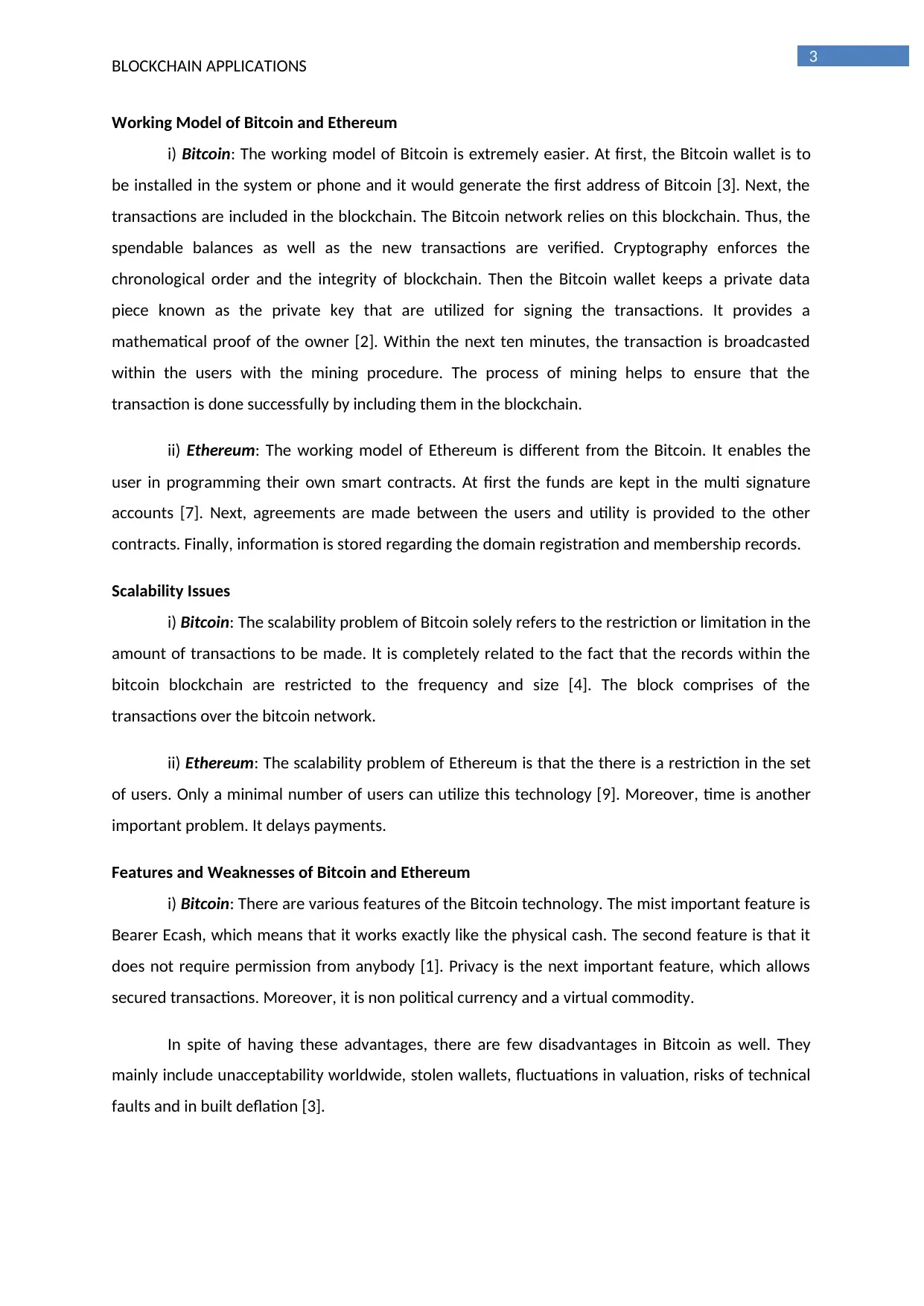
3
BLOCKCHAIN APPLICATIONS
Working Model of Bitcoin and Ethereum
i) Bitcoin: The working model of Bitcoin is extremely easier. At first, the Bitcoin wallet is to
be installed in the system or phone and it would generate the first address of Bitcoin [3]. Next, the
transactions are included in the blockchain. The Bitcoin network relies on this blockchain. Thus, the
spendable balances as well as the new transactions are verified. Cryptography enforces the
chronological order and the integrity of blockchain. Then the Bitcoin wallet keeps a private data
piece known as the private key that are utilized for signing the transactions. It provides a
mathematical proof of the owner [2]. Within the next ten minutes, the transaction is broadcasted
within the users with the mining procedure. The process of mining helps to ensure that the
transaction is done successfully by including them in the blockchain.
ii) Ethereum: The working model of Ethereum is different from the Bitcoin. It enables the
user in programming their own smart contracts. At first the funds are kept in the multi signature
accounts [7]. Next, agreements are made between the users and utility is provided to the other
contracts. Finally, information is stored regarding the domain registration and membership records.
Scalability Issues
i) Bitcoin: The scalability problem of Bitcoin solely refers to the restriction or limitation in the
amount of transactions to be made. It is completely related to the fact that the records within the
bitcoin blockchain are restricted to the frequency and size [4]. The block comprises of the
transactions over the bitcoin network.
ii) Ethereum: The scalability problem of Ethereum is that the there is a restriction in the set
of users. Only a minimal number of users can utilize this technology [9]. Moreover, time is another
important problem. It delays payments.
Features and Weaknesses of Bitcoin and Ethereum
i) Bitcoin: There are various features of the Bitcoin technology. The mist important feature is
Bearer Ecash, which means that it works exactly like the physical cash. The second feature is that it
does not require permission from anybody [1]. Privacy is the next important feature, which allows
secured transactions. Moreover, it is non political currency and a virtual commodity.
In spite of having these advantages, there are few disadvantages in Bitcoin as well. They
mainly include unacceptability worldwide, stolen wallets, fluctuations in valuation, risks of technical
faults and in built deflation [3].
BLOCKCHAIN APPLICATIONS
Working Model of Bitcoin and Ethereum
i) Bitcoin: The working model of Bitcoin is extremely easier. At first, the Bitcoin wallet is to
be installed in the system or phone and it would generate the first address of Bitcoin [3]. Next, the
transactions are included in the blockchain. The Bitcoin network relies on this blockchain. Thus, the
spendable balances as well as the new transactions are verified. Cryptography enforces the
chronological order and the integrity of blockchain. Then the Bitcoin wallet keeps a private data
piece known as the private key that are utilized for signing the transactions. It provides a
mathematical proof of the owner [2]. Within the next ten minutes, the transaction is broadcasted
within the users with the mining procedure. The process of mining helps to ensure that the
transaction is done successfully by including them in the blockchain.
ii) Ethereum: The working model of Ethereum is different from the Bitcoin. It enables the
user in programming their own smart contracts. At first the funds are kept in the multi signature
accounts [7]. Next, agreements are made between the users and utility is provided to the other
contracts. Finally, information is stored regarding the domain registration and membership records.
Scalability Issues
i) Bitcoin: The scalability problem of Bitcoin solely refers to the restriction or limitation in the
amount of transactions to be made. It is completely related to the fact that the records within the
bitcoin blockchain are restricted to the frequency and size [4]. The block comprises of the
transactions over the bitcoin network.
ii) Ethereum: The scalability problem of Ethereum is that the there is a restriction in the set
of users. Only a minimal number of users can utilize this technology [9]. Moreover, time is another
important problem. It delays payments.
Features and Weaknesses of Bitcoin and Ethereum
i) Bitcoin: There are various features of the Bitcoin technology. The mist important feature is
Bearer Ecash, which means that it works exactly like the physical cash. The second feature is that it
does not require permission from anybody [1]. Privacy is the next important feature, which allows
secured transactions. Moreover, it is non political currency and a virtual commodity.
In spite of having these advantages, there are few disadvantages in Bitcoin as well. They
mainly include unacceptability worldwide, stolen wallets, fluctuations in valuation, risks of technical
faults and in built deflation [3].
Secure Best Marks with AI Grader
Need help grading? Try our AI Grader for instant feedback on your assignments.
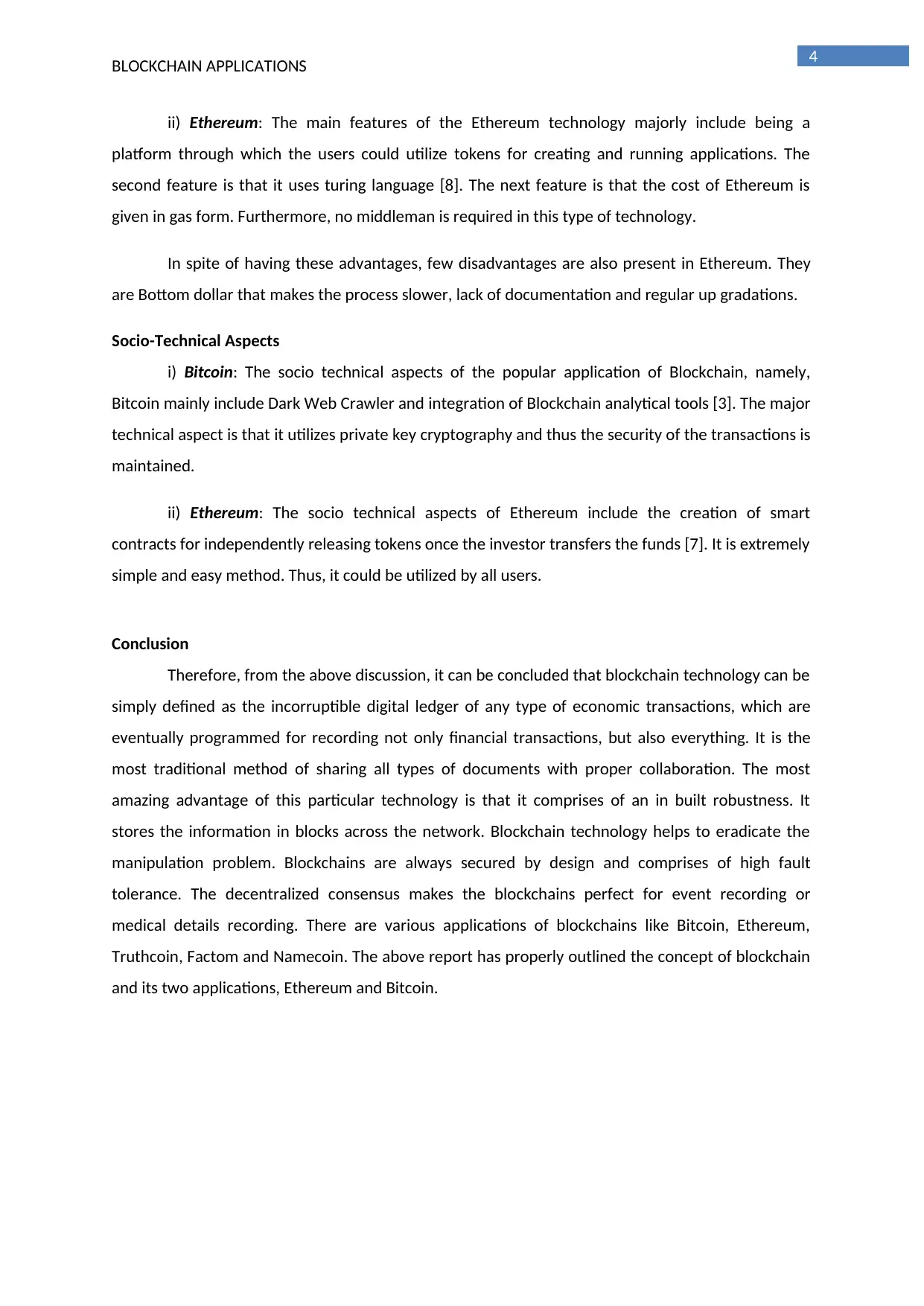
4
BLOCKCHAIN APPLICATIONS
ii) Ethereum: The main features of the Ethereum technology majorly include being a
platform through which the users could utilize tokens for creating and running applications. The
second feature is that it uses turing language [8]. The next feature is that the cost of Ethereum is
given in gas form. Furthermore, no middleman is required in this type of technology.
In spite of having these advantages, few disadvantages are also present in Ethereum. They
are Bottom dollar that makes the process slower, lack of documentation and regular up gradations.
Socio-Technical Aspects
i) Bitcoin: The socio technical aspects of the popular application of Blockchain, namely,
Bitcoin mainly include Dark Web Crawler and integration of Blockchain analytical tools [3]. The major
technical aspect is that it utilizes private key cryptography and thus the security of the transactions is
maintained.
ii) Ethereum: The socio technical aspects of Ethereum include the creation of smart
contracts for independently releasing tokens once the investor transfers the funds [7]. It is extremely
simple and easy method. Thus, it could be utilized by all users.
Conclusion
Therefore, from the above discussion, it can be concluded that blockchain technology can be
simply defined as the incorruptible digital ledger of any type of economic transactions, which are
eventually programmed for recording not only financial transactions, but also everything. It is the
most traditional method of sharing all types of documents with proper collaboration. The most
amazing advantage of this particular technology is that it comprises of an in built robustness. It
stores the information in blocks across the network. Blockchain technology helps to eradicate the
manipulation problem. Blockchains are always secured by design and comprises of high fault
tolerance. The decentralized consensus makes the blockchains perfect for event recording or
medical details recording. There are various applications of blockchains like Bitcoin, Ethereum,
Truthcoin, Factom and Namecoin. The above report has properly outlined the concept of blockchain
and its two applications, Ethereum and Bitcoin.
BLOCKCHAIN APPLICATIONS
ii) Ethereum: The main features of the Ethereum technology majorly include being a
platform through which the users could utilize tokens for creating and running applications. The
second feature is that it uses turing language [8]. The next feature is that the cost of Ethereum is
given in gas form. Furthermore, no middleman is required in this type of technology.
In spite of having these advantages, few disadvantages are also present in Ethereum. They
are Bottom dollar that makes the process slower, lack of documentation and regular up gradations.
Socio-Technical Aspects
i) Bitcoin: The socio technical aspects of the popular application of Blockchain, namely,
Bitcoin mainly include Dark Web Crawler and integration of Blockchain analytical tools [3]. The major
technical aspect is that it utilizes private key cryptography and thus the security of the transactions is
maintained.
ii) Ethereum: The socio technical aspects of Ethereum include the creation of smart
contracts for independently releasing tokens once the investor transfers the funds [7]. It is extremely
simple and easy method. Thus, it could be utilized by all users.
Conclusion
Therefore, from the above discussion, it can be concluded that blockchain technology can be
simply defined as the incorruptible digital ledger of any type of economic transactions, which are
eventually programmed for recording not only financial transactions, but also everything. It is the
most traditional method of sharing all types of documents with proper collaboration. The most
amazing advantage of this particular technology is that it comprises of an in built robustness. It
stores the information in blocks across the network. Blockchain technology helps to eradicate the
manipulation problem. Blockchains are always secured by design and comprises of high fault
tolerance. The decentralized consensus makes the blockchains perfect for event recording or
medical details recording. There are various applications of blockchains like Bitcoin, Ethereum,
Truthcoin, Factom and Namecoin. The above report has properly outlined the concept of blockchain
and its two applications, Ethereum and Bitcoin.
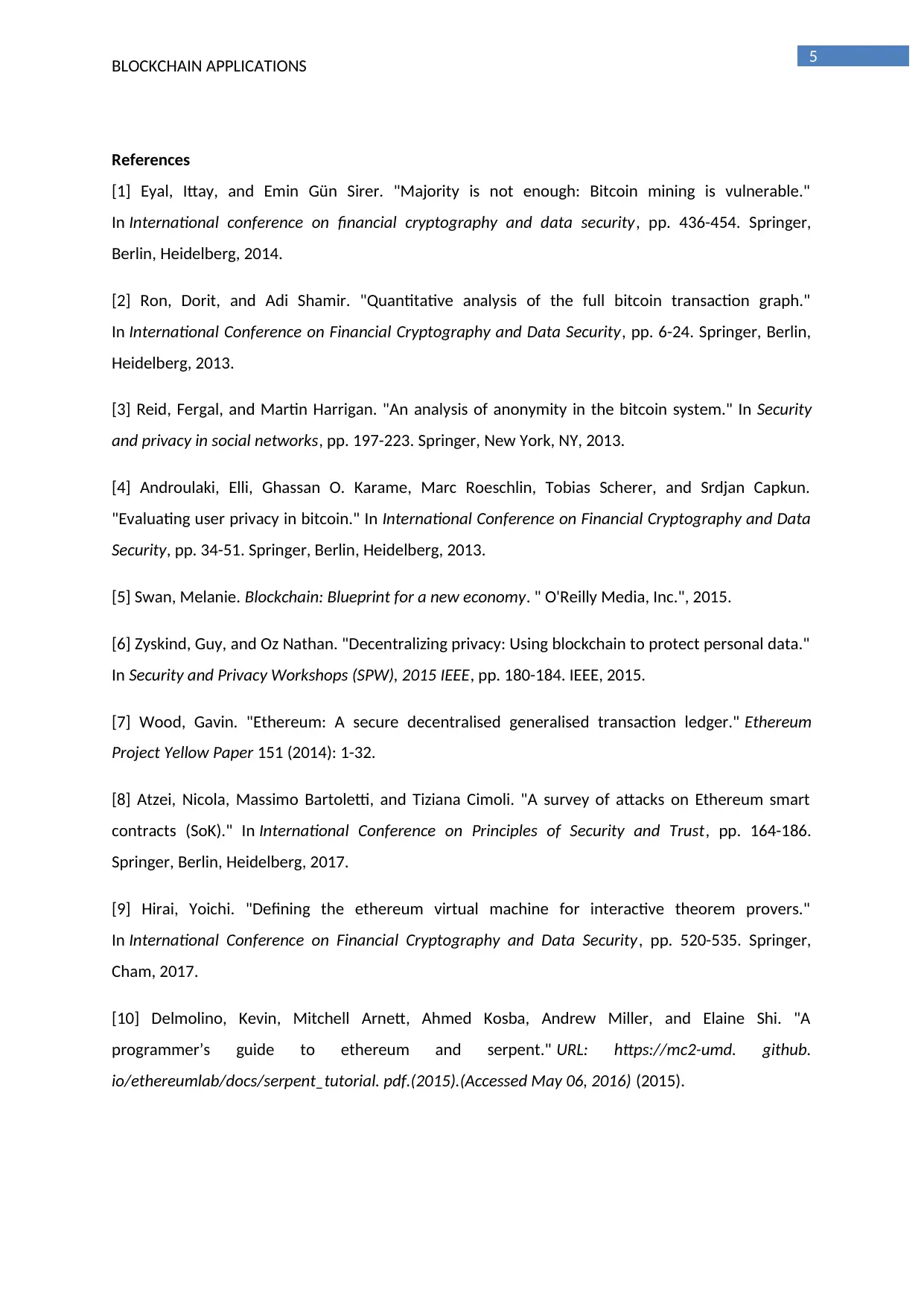
5
BLOCKCHAIN APPLICATIONS
References
[1] Eyal, Ittay, and Emin Gün Sirer. "Majority is not enough: Bitcoin mining is vulnerable."
In International conference on financial cryptography and data security, pp. 436-454. Springer,
Berlin, Heidelberg, 2014.
[2] Ron, Dorit, and Adi Shamir. "Quantitative analysis of the full bitcoin transaction graph."
In International Conference on Financial Cryptography and Data Security, pp. 6-24. Springer, Berlin,
Heidelberg, 2013.
[3] Reid, Fergal, and Martin Harrigan. "An analysis of anonymity in the bitcoin system." In Security
and privacy in social networks, pp. 197-223. Springer, New York, NY, 2013.
[4] Androulaki, Elli, Ghassan O. Karame, Marc Roeschlin, Tobias Scherer, and Srdjan Capkun.
"Evaluating user privacy in bitcoin." In International Conference on Financial Cryptography and Data
Security, pp. 34-51. Springer, Berlin, Heidelberg, 2013.
[5] Swan, Melanie. Blockchain: Blueprint for a new economy. " O'Reilly Media, Inc.", 2015.
[6] Zyskind, Guy, and Oz Nathan. "Decentralizing privacy: Using blockchain to protect personal data."
In Security and Privacy Workshops (SPW), 2015 IEEE, pp. 180-184. IEEE, 2015.
[7] Wood, Gavin. "Ethereum: A secure decentralised generalised transaction ledger." Ethereum
Project Yellow Paper 151 (2014): 1-32.
[8] Atzei, Nicola, Massimo Bartoletti, and Tiziana Cimoli. "A survey of attacks on Ethereum smart
contracts (SoK)." In International Conference on Principles of Security and Trust, pp. 164-186.
Springer, Berlin, Heidelberg, 2017.
[9] Hirai, Yoichi. "Defining the ethereum virtual machine for interactive theorem provers."
In International Conference on Financial Cryptography and Data Security, pp. 520-535. Springer,
Cham, 2017.
[10] Delmolino, Kevin, Mitchell Arnett, Ahmed Kosba, Andrew Miller, and Elaine Shi. "A
programmer’s guide to ethereum and serpent." URL: https://mc2-umd. github.
io/ethereumlab/docs/serpent_tutorial. pdf.(2015).(Accessed May 06, 2016) (2015).
BLOCKCHAIN APPLICATIONS
References
[1] Eyal, Ittay, and Emin Gün Sirer. "Majority is not enough: Bitcoin mining is vulnerable."
In International conference on financial cryptography and data security, pp. 436-454. Springer,
Berlin, Heidelberg, 2014.
[2] Ron, Dorit, and Adi Shamir. "Quantitative analysis of the full bitcoin transaction graph."
In International Conference on Financial Cryptography and Data Security, pp. 6-24. Springer, Berlin,
Heidelberg, 2013.
[3] Reid, Fergal, and Martin Harrigan. "An analysis of anonymity in the bitcoin system." In Security
and privacy in social networks, pp. 197-223. Springer, New York, NY, 2013.
[4] Androulaki, Elli, Ghassan O. Karame, Marc Roeschlin, Tobias Scherer, and Srdjan Capkun.
"Evaluating user privacy in bitcoin." In International Conference on Financial Cryptography and Data
Security, pp. 34-51. Springer, Berlin, Heidelberg, 2013.
[5] Swan, Melanie. Blockchain: Blueprint for a new economy. " O'Reilly Media, Inc.", 2015.
[6] Zyskind, Guy, and Oz Nathan. "Decentralizing privacy: Using blockchain to protect personal data."
In Security and Privacy Workshops (SPW), 2015 IEEE, pp. 180-184. IEEE, 2015.
[7] Wood, Gavin. "Ethereum: A secure decentralised generalised transaction ledger." Ethereum
Project Yellow Paper 151 (2014): 1-32.
[8] Atzei, Nicola, Massimo Bartoletti, and Tiziana Cimoli. "A survey of attacks on Ethereum smart
contracts (SoK)." In International Conference on Principles of Security and Trust, pp. 164-186.
Springer, Berlin, Heidelberg, 2017.
[9] Hirai, Yoichi. "Defining the ethereum virtual machine for interactive theorem provers."
In International Conference on Financial Cryptography and Data Security, pp. 520-535. Springer,
Cham, 2017.
[10] Delmolino, Kevin, Mitchell Arnett, Ahmed Kosba, Andrew Miller, and Elaine Shi. "A
programmer’s guide to ethereum and serpent." URL: https://mc2-umd. github.
io/ethereumlab/docs/serpent_tutorial. pdf.(2015).(Accessed May 06, 2016) (2015).
1 out of 6
Related Documents
Your All-in-One AI-Powered Toolkit for Academic Success.
+13062052269
info@desklib.com
Available 24*7 on WhatsApp / Email
![[object Object]](/_next/static/media/star-bottom.7253800d.svg)
Unlock your academic potential
© 2024 | Zucol Services PVT LTD | All rights reserved.





